The Fascinating Journey of Man-Made Diamonds
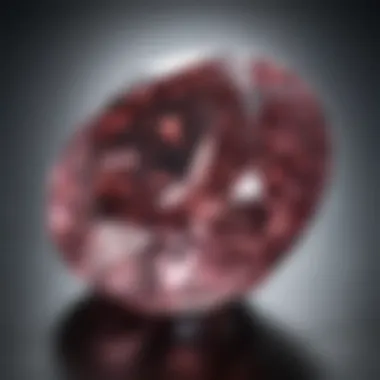
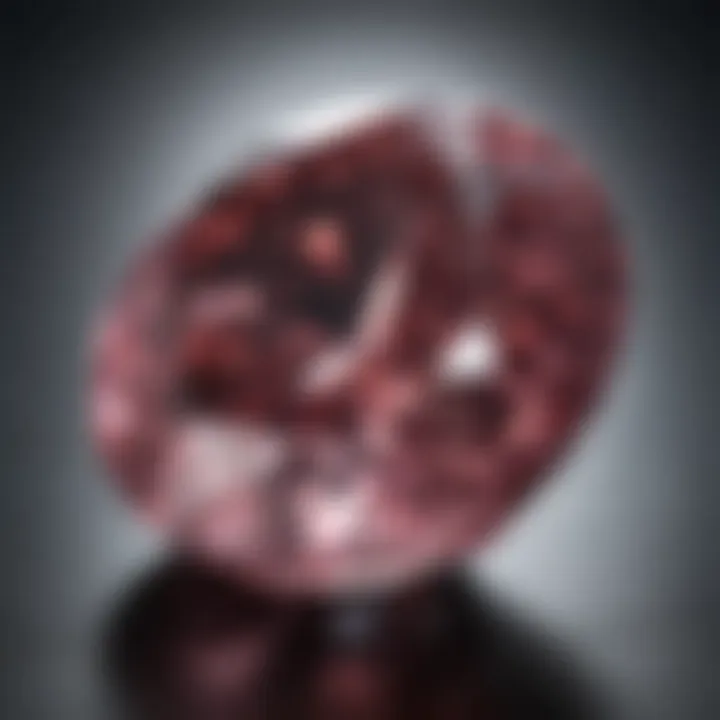
Intro
The realm of gemstones has always captivated humanity. From ancient times to the present, people have been drawn to their beauty and rarity. However, the rise of man-made diamonds introduces a new narrative in the gemstone ecosystem. This exploration dives deep into synthetic gemstones, shining a spotlight on what they are, their creation, and their implications for the jewelry market.
A diamond, regardless of its origin, possesses a unique allure. Man-made diamonds, produced in laboratories, offer an alternative to their naturally mined counterparts. Understanding this fascinating evolution requires a closer look into gems themselves, their classification, and their deep-rooted historical significance.
As we chart our course through this article, we will uncover not just the features of man-made diamonds but also probe into the broader context of gemstones. Get ready to discover how these lab-grown marvels are transforming consumer choices and changing perceptions in the jewelry industry.
Gemstone Overview
Definition of Gemstones
Gemstones are defined as precious or semi-precious stones that are cherished for their beauty and rarity. They are often used in jewelry and ornaments, serving as symbols of wealth or personal taste. The brilliance and light refraction of these stones make them desirable, whether they are naturally occurring or synthesized.
Gemstones can also be classified according to various characteristics—most notably, by their chemical composition, origin, and hardness. For example, diamonds, rubies, and sapphires belong to different categories based on their mineral structure.
Classification of Gemstones
When it comes to classifying gemstones, the distinction between natural and synthetic is particularly significant. Here’s a simple breakdown of key classifications:
- Natural Gemstones: Formed through geological processes without human intervention. Examples include diamond, emerald, and opal.
- Synthetic Gemstones: Created in laboratories, these gems mirror their natural counterparts in chemical composition and physical characteristics. Man-made diamonds fall under this category.
- Organic Gemstones: Derived from living organisms. Classic examples are pearls and amber.
"Synthetic diamonds carry the same physical properties as natural diamonds—they are chemically and optically identical."
By understanding these classifications, we can better appreciate the remarkable technical achievement behind synthetic gemstones and the allure they hold for today's consumers.
Historical Significance
Origins of Gemstone Use
The use of gemstones dates back to ancient civilizations. These precious stones have adorned rulers, served as talismans, and been used in religious ceremonies. Archaeological findings suggest that human beings have valued these geological treasures for thousands of years.
Cultural Insights: Gemstones in Ancient Civilizations
In ancient Egypt, lapis lazuli was considered a stone of the gods, while in ancient India, gemstones were associated with astrological significance. Each culture imbued its gems with meanings, transforming mere rocks into symbols of status, power, and spirituality. In many ways, the cultural lenses through which we view gemstones are as profound as the gems themselves.
Through examining the history of gemstones, we can draw connections to how modern perceptions of synthetic diamonds are evolving. This narrative serves as a foundation for grasping the contemporary dialogue surrounding man-made diamonds and their place in the gemstone market.
Prelims to Man-Made Diamonds
Man-made diamonds, often called synthetic diamonds, have gained considerable attention in recent years as a captivating alternative to their natural counterparts. This shift in focus stems from various interlinked factors, ranging from environmental concerns to economic considerations. In a world that increasingly values sustainability, the production of diamonds without the significant ecological toll associated with traditional mining practices has piqued interest among consumers and industry stakeholders alike.
The relevance of man-made diamonds extends beyond their environmental impact. These gemstones offer a range of benefits that cater to the needs of discerning buyers. For instance, the price point is typically lower, making luxurious options more accessible to a wider audience. Additionally, the ethical implications of sourcing diamonds responsibly resonate with a growing number of consumers who are conscious about the origins of their products.
Synthetic diamonds are produced using advanced techniques that mimic the conditions under which natural diamonds form, achieving the same brilliance and durability. Understanding this process not only illuminates the differences between natural and synthetic diamonds, but also enriches consumers' appreciation for these gems.
"The allure of man-made diamonds lies not only in their beauty but in their story of creation, sustainability, and ethical responsibility."
As we delve deeper into this topic, we'll explore the nuances of how man-made diamonds are formed, their properties, market dynamics, and cultural perceptions.
Key Points to Consider:
- Sustainability: Man-made diamonds are seen as a more eco-friendly option.
- Affordability: Generally, synthetic diamonds cost less than natural ones.
- Ethics: The production methods circumvent many ethical issues associated with diamond mining.
In summation, the introduction of man-made diamonds provides a compelling case for their growing popularity in the jewelry industry. As consumers become more educated about their options, the allure of these synthetic treasures will likely continue to grow.
Understanding Diamond Formation
When delving into the world of man-made diamonds, understanding their formation is key. Knowing how these synthetic gems are created provides insight into their quality, value, and the technological advancements behind them. It's vital for both gemstone enthusiasts and collectors to grasp the processes that differentiate natural diamonds from their man-made counterparts.
From a geological perspective, diamonds are often thought of as nature’s masterpieces, formed deep within the Earth under extreme conditions over millions of years. In contrast, man-made diamonds, or synthetic diamonds, replicate this natural process within a matter of days or weeks. This begs the question: what drives the creation of these lab-grown gems?
Through innovations in techniques, consumers are now able to access diamonds that possess the same physical and chemical properties as natural diamonds at a more attainable cost.
Natural vs. Synthetic Formation Methods
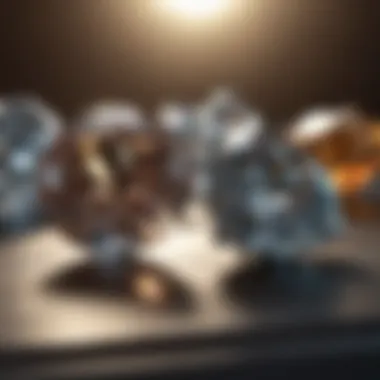
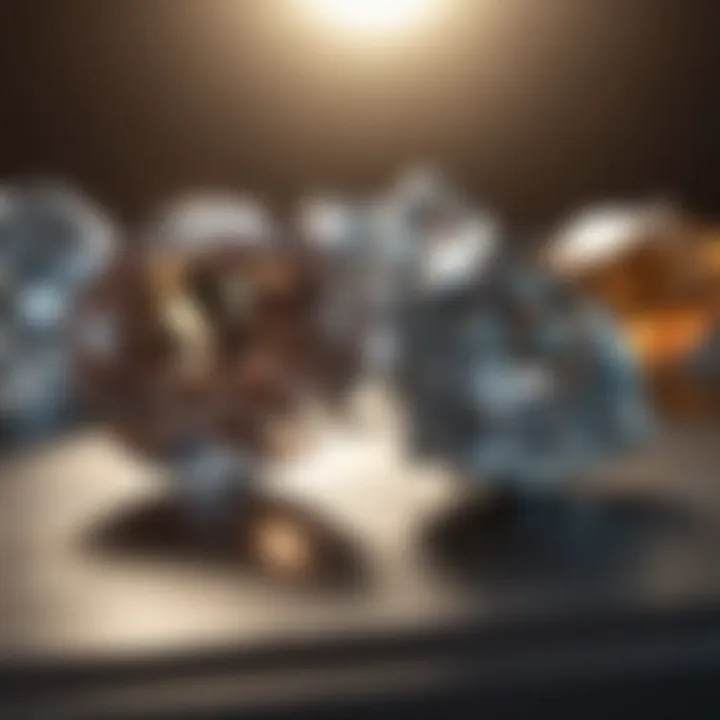
The distinction between natural and synthetic diamonds lies primarily in their formation methods, which is critical in understanding their respective markets.
- Natural Diamonds: Formed in a natural setting under immense geological pressure and heat, these diamonds take billions of years to develop. The processes involve carbon atoms bonding in a unique crystal structure, resulting in a gemstone that’s not only valuable but rich in history.
- Synthetic Diamonds: Created through human ingenuity, these diamonds employ methods such as Chemical Vapor Deposition (CVD) and High Pressure High Temperature (HPHT) to replicate the natural formation process. As a result, synthetic diamonds show similar characteristics to natural diamonds but can often be produced at a fraction of the time and cost.
Understanding these differences helps consumers make informed decisions. Many perceive natural diamonds as more prestigious, while synthetic diamonds are often viewed through a lens of innovation and sustainability. Each viewpoint feeds into the conversation about the evolving nature of value in the gemstone market.
Chemical Vapor Deposition ()
Chemical Vapor Deposition, or CVD, is one of the most celebrated methods for creating man-made diamonds. This technique involves the transformation of gaseous carbon into diamond crystals under controlled conditions. The process allows for precision in creating high-quality diamonds with fewer imperfections.
In essence, a substrate is placed inside a chamber where a carbon-rich gas, such as methane, is introduced along with hydrogen gas. Under the influence of heat, typically from a microwave, the gas breaks down, leading to the deposition of carbon onto the substrate, gradually forming a diamond layer.
"CVD diamonds are often heralded for their purity and clarity, making them an attractive choice for many buyers."
CVD has become quite popular not just for its efficiency but also for its capacity to produce diamonds in a range of colors. This method can create fancy colored diamonds which naturally occur but are extremely rare in their natural form. With the growing desire for unique gemstone varieties, CVD has indeed piped up the demand for synthetic diamonds.
High Pressure High Temperature (HPHT)
On the flip side, HPHT is another essential method used to create man-made diamonds. This process aims to emulate the natural conditions under which diamonds are formed, thus being labeled as a more straightforward replication of nature. In HPHT, a carbon source is subjected to extreme pressure and temperature in order to facilitate the diamond crystallization process.
The core of the HPHT apparatus typically includes a press that generates extreme conditions mimicking the Earth's mantle, where natural diamonds form. A small diamond seed is placed alongside carbon, and under the right combination of heat and pressure, diamond crystals begin to develop around the seed.
The resultant diamonds from the HPHT process can possess distinct characteristics, often referred to as "synthetic fingerprints", which highlight their artificial nature. While many appreciate the simplicity of the process, some enthusiasts argue that these characteristics can sometimes diminish a diamond's perceived value.
Overall, both CVD and HPHT play pivotal roles in shaping the landscape of man-made diamonds, offering alternatives to traditional diamonds while addressing criticisms of the environmental footprint associated with mining.
Understanding the formation methods of diamonds not only enhances appreciation for these gems but also informs choices in both consumer and market dynamics. Consumers can choose accordingly, aligning their values with their diamond decisions.
Properties of Man-Made Diamonds
Examining the properties of man-made diamonds is crucial to understand their role in today's market and the evolving perceptions surrounding them. These synthetic gemstones aren’t just physical replicas of their natural counterparts; they embody unique characteristics that offer both aesthetic appeal and practical benefits. Armed with knowledge about these properties, gemstone enthusiasts, collectors, and jewelry designers can make informed choices that rest on both beauty and value.
Physical Characteristics
The physical characteristics of man-made diamonds are striking in their similarity to natural diamonds, though there are nuances worth noting. First off, just like natural stones, synthetic diamonds can vary across a spectrum of colors; some may display a transparent, icy brilliance while others sparkle with rich hues.
- Clarity: Most manufactured diamonds are graded as VS1 (very slightly included) or better. The advancements in technology used to create these stones have led to fewer inclusions or flaws.
- Color Variety: Natural diamonds are famously known for their preference for colorlessness; however, synthetic gems can often be engineered to exhibit vibrant shades, including pinks, blues, and greens, without the premium price tag of their natural equivalents.
- Size Versatility: Often, these diamonds can be produced larger than natural stones without going through the same rigmaroles, allowing for the creation of stunning jewelry pieces that offer value without compromises.
"In practical terms, manufactured diamonds offer unparalleled clarity, color variation, and size relative to cost."
Optical Properties
The allure of man-made diamonds isn't just skin deep. Their optical properties play a significant role in their desirability. By definition, diamonds refract light exquisitely, producing the characteristic sparkle and fire that enchants many. Man-made diamonds mimic this exceptionally well:
- Brilliance: These stones have been crafted to reflect light similarly to natural diamonds, enhancing their asthetic appeal. A quality man-made diamond will exhibit a brilliance and scintillation that can dazzle the most discerning eye.
- Dispersion: Known as the ‘fire’ of the diamond, the ability to separate light into a rainbow of colors is a another area where synthetic diamonds shine. This characteristic can evoke emotions and signify luxury, much like natural diamonds would.
The optical performance of synthetic diamonds can often match or sometimes exceed that of natural stones, showcasing their superior quality and beauty.
Durability and Hardness
When it comes to durability, man-made diamonds are on solid ground. Diamond, by its nature, is the hardest known substance on Earth. Both natural and synthetic diamonds rank a perfect 10 on the Mohs scale of mineral hardness. This means:
- Scratch Resistance: Both types are incredibly resilient, making them appropriate for everyday wear — perfect for engagement rings or cherished heirlooms.
- Long-Lasting Value: The durability of these diamonds implies less maintenance and lower risks of damage, making them an excellent investment over time.
The choice of synthetic diamonds opens up a world of possibilities without sacrificing the core attributes that have made diamonds beloved for centuries.
In reviewing the properties of man-made diamonds, one finds more than just a functional gemstone; these attributes merge aesthetic value with practical advantages, appealing to a diverse audience eager to explore this new world.
Market Dynamics of Man-Made Diamonds
The rise of man-made diamonds has significantly altered the dynamics of the gemstone market. As technology advances and consumer preferences evolve, these diamonds are carving a niche that challenges traditional norms. Understanding the market dynamics involves grasping the forces at play, from consumer acceptance to price competition. The interplay between these elements shapes an intriguing landscape where market trends and forecasts provide a glimpse into the future of synthetic gemstones.
Consumer Acceptance
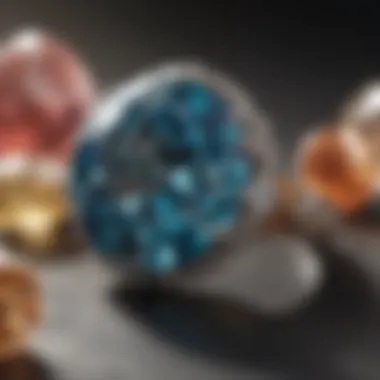
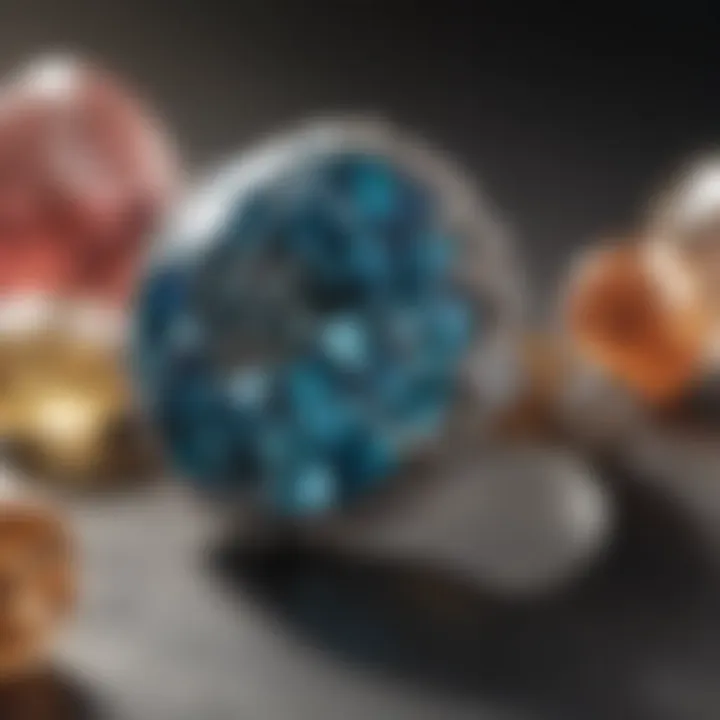
A significant factor in the market dynamics of man-made diamonds is consumer acceptance. Initially met with skepticism, many buyers now see these diamonds as a viable and sometimes superior alternative to natural ones. This shift is fueled by a broadening awareness of ethical sourcing and environmental sustainability. Awareness campaigns and social media have done their part in educating the public. The millennial and Gen Z populations, in particular, are keen on making conscious choices and align their spending with their values.
- These diamonds are often perceived as conflict-free, alleviating concerns surrounding exploitation in mining.
- The quality is consistent, which allows consumers to make more informed choices.
- A growing number of influencers and celebrities are showcasing man-made diamonds, further enhancing their appeal.
Price Comparison with Natural Diamonds
When we dive into the price comparison aspect, the figures tell a compelling story. Generally, man-made diamonds are less expensive than their natural counterparts, sometimes by as much as 30 to 50%. This has significant implications for consumers who seek high-quality stones without breaking the bank.
- For buyers, this lower price point means larger carat weights can be obtained for the same budget.
- For retailers, it creates a competitive landscape, encouraging promotions and discounts that attract more customers.
- As price transparency grows, educated consumers are attracted to man-made diamonds, appreciating the value they bring without the hefty price tag.
Indeed, this price comparison is reshaping buyer behavior. Where once the allure of natural rarity drove sales, buyers today are scrutinizing the benefits of cost and ethical production.
Market Trends and Forecasts
Looking ahead, the market trends indicate a promising future for man-made diamonds. As they gain traction, we can expect an increase in both demand and innovation.
- Technological advancements are consistently improving the quality and reducing the production costs of synthetic diamonds, making them ever more accessible.
- The market is likely to see an uptick in bespoke and personalized jewelry offerings, fulfilling a growing consumer desire for unique pieces.
- Analysts predict that the market share for man-made diamonds could reach notable highs, possibly overtaking natural diamonds in specific segments by 2030.
"As consumer values shift toward sustainability, the charm of man-made diamonds will only grow stronger, setting a new standard for the future of the jewelry industry."
The future looks bright not just for consumers but also for the entire jewelry industry, which may well embrace man-made diamonds as a symbol of modern values.
Environmental Impact of Diamond Production
The growing interest in man-made diamonds has led many to question the environmental implications associated with both synthetic and natural diamond production. Mining natural diamonds, as previously done for decades, comes with a hefty price tag on the planet. It transforms landscapes, disturbs ecosystems, and usually involves significant resource consumption, often leaving a scar on the earth that can be seen for years. When discussing the allure of man-made diamonds, it's crucial to highlight how their production can potentially mitigate these environmental concerns.
Sustainability Considerations
Man-made diamonds are generally seen as a more sustainable alternative to their mined counterparts. One of the core principles of sustainability is minimizing resource depletion and environmental degradation, which synthetic diamonds achieve by using advanced technologies that carry less environmental burden.
- Less Land Disruption: The creation of lab-grown diamonds requires considerably less land than traditional mining operations. Since the production takes place in controlled environments, there’s no need to clear forest land or disrupt local wildlife habitats.
- Resource Efficiency: Natural diamond mining heavily relies on water and energy, often leading to wastage and pollution of local water sources. In contrast, man-made diamonds can be produced using methods that require less water, hence preserving local ecosystems.
- Ethical Production: The ethical dilemma surrounding conflict diamonds often spurs debate in the jewelry industry, with many consumers desiring transparency in sourcing. Synthetic diamonds are conflict-free by nature, as they are grown in labs rather than extracted from the ground.
In summary, choosing man-made diamonds over mined alternatives can contribute to a more sustainable future for the gemstone industry and the earth.
Carbon Footprint Analysis
Exploring the carbon footprint associated with diamond production initiatives a fascinating look at the broader environmental construct.
Research indicates that man-made diamonds often exhibit a reduced carbon footprint compared to traditional mined diamonds. Let's dig a bit deeper into this topic:
- Energy Sources: The energy required to produce synthetic diamonds largely hinges on the methods employed. While some production routes utilize fossil fuels, many labs are transitioning to renewable energy sources, which significantly lowers the overall carbon output.
- Transportation Emissions: Another aspect is transportation. Natural diamonds are often transported across continents, contributing to high emissions levels due to shipping practices. In contrast, many manufacturers of lab-grown diamonds operate locally, meaning less transport is required, resulting in lower greenhouse gas emissions overall.
By examining the carbon footprint analysis of man-made diamonds, it's evident that they present an opportunity for a reduced environmental toll. As consumer awareness regarding climate change rises, the choices they make in gemstone purchases could very well contribute to a more sustainable world.
Cultural Perceptions of Man-Made Diamonds
In recent years, the discourse surrounding man-made diamonds has shifted significantly, reflecting changing cultural perceptions. Man-made diamonds, once overshadowed by their natural counterparts, are now appreciated for various reasons ranging from ethical considerations to innovative design possibilities. This section delves into the importance of cultural perceptions as they relate to synthetic gemstones, highlighting how they influence the market and consumer attitudes towards these gems.
Changing Attitudes in Jewelry Design
The jewelry design landscape has embraced man-made diamonds with open arms, as designers recognize the diverse attributes these stones bring to the table. Unlike traditional diamonds, which can be difficult to source ethically, man-made options offer unparalleled transparency in their origin. This has sparked a wave of creativity, encouraging designers to explore unique styles and settings that showcase the versatility of synthetic gems.
From engagement rings that prioritize sustainability to avant-garde pieces centered on striking aesthetics, designers are increasingly experimenting with man-made diamonds. This collaboration between innovation and tradition reshapes consumer expectations about what a diamond can represent. The design process has become more inclusive, catering to environmentally-conscious buyers without sacrificing beauty or quality.
"Man-made diamonds aren't just replications; they are a new canvas for artistic expression."
Further, the surge in consumer demand for personalization has led to more tailored jewelry options featuring man-made diamonds. Customization—be it in cuts, colors, or settings—has emerged as a prominent trend, allowing consumers to wear pieces that resonate with their personal story. This evolution redefines jewelry not just as a luxury, but as a medium of self-expression.
Symbolism and Meaning
Historically, diamonds have stood as symbols of wealth and status, often intertwined with notions of eternal love. However, the rise of man-made diamonds has prompted a reevaluation of what these stones signify in contemporary culture. Increasingly, consumers are gravitating toward the idea that value is not just measured in carats or price tags, but also in the principles surrounding their creation.
The narrative of man-made diamonds is largely centered around sustainability and ethics. The significance of choosing a synthetic diamond often embodies commitment to environmental stewardship and social responsibility. Shoppers are now more likely to associate these gems with progressive values, whereby opting for man-made means supporting sustainable practices and reducing ecological impact.
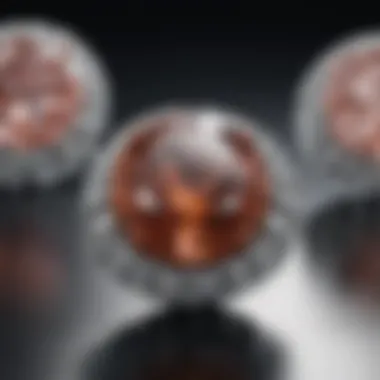
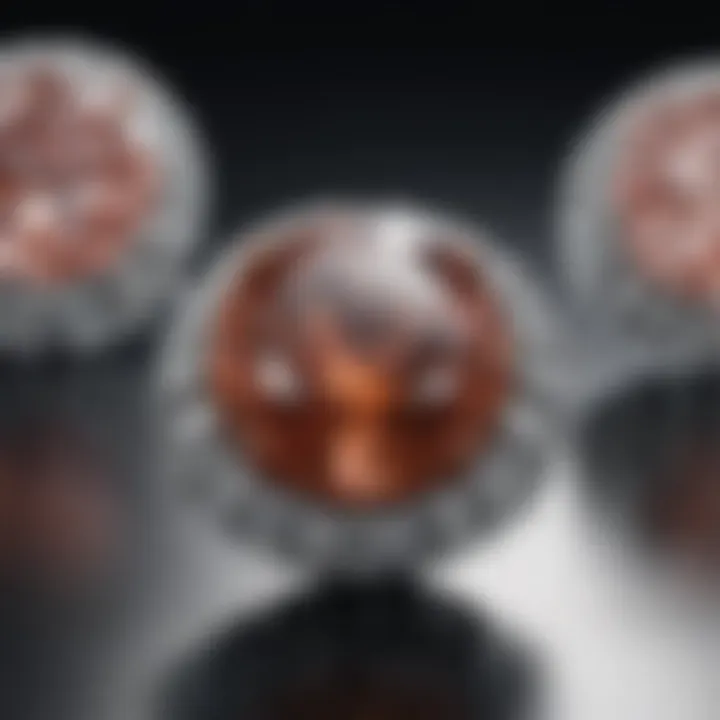
As such, the sentimentality surrounding man-made diamonds has shifted. They are often seen not merely as substitutes for natural stones but rather as meaningful choices that reflect one's personal values. This transformed meaning fosters a deeper connection between the wearer and the gemstone, successfully blurring the lines between luxury and ethical consumption.
In summary, the cultural perceptions of man-made diamonds highlight their evolving role in jewelry making and personal symbolism. As attitudes continue to evolve, we can expect these synthetic gems to maintain a prominent place in both conversations around design and ethical consumption.
Man-Made Diamonds in Art and Design
Man-made diamonds have become a significant component of the contemporary art and design world. Their rise is not just a trend; rather, it's a transformation that has significant implications for both artists and consumers. These synthetic gemstones offer endless creative possibilities and influence how jewelry is conceived and manufactured.
Innovations in Jewelry Making
The introduction of man-made diamonds has sparked a wave of innovations in jewelry making. Designers find themselves able to push boundaries, creating pieces that were once thought impossible. One major advantage is the ability to produce gems with specific characteristics on demand. For instance, artists can craft diamonds in various hues, like deep blues or vibrant pinks, which are uncommon in nature. This opens up a palette of options that allows designers to tailor their creations in a way that feels personal and unique.
Furthermore, the processes for creating these synthetic stones—like Chemical Vapor Deposition (CVD) and High Pressure High Temperature (HPHT)—allow for a level of precision that can lead to intricate designs that capture light in new ways. This technology also enables designers to to reduce waste and produce high-quality stones that can be both stunning and ethically sourced.
- Benefits include:
- Greater customization options
- Ethical sourcing possibilities
- Reduced environmental impact compared to mined diamonds
As the industry continues to evolve, it's likely that we will see even more experimentation with styles and settings, integrating man-made diamonds into unusual and eye-catching designs.
Influence on Fashion Trends
The impact of man-made diamonds on fashion extends beyond mere aesthetics. They’ve redefined luxury and status associated with diamonds. No longer solely reserved for elite clientele, man-made diamonds now cater to a broader market. This shift encourages diverse fashion trends across various demographics.
Fashion influencers and designers are increasingly incorporating man-made diamonds into their collections, showcasing them in runway shows and social media campaigns. The very notion that sustainable choices can align with high-fashion aesthetics challenges old beliefs. It invites a fresh conversation about what luxury truly means today.
- Current trends include:
- Sustainable luxury: Fashion lines focusing on eco-friendly practices are gaining traction.
- Personalization: Consumers are moving toward pieces that reflect their individuality, often using these unique synthetic gems.
- Wider availability and pricing: As these alternatives become mainstream, they challenge conventional notions of diamond prices—a strong point for both aesthetics and ethics.
Man-made diamonds have reimagined the role of gems in jewelry, making them not just adornments but statements of identity and values.
Ultimately, the world of man-made diamonds isn't just about creating something beautiful; it encompasses a larger narrative about sustainability, innovation, and a shift in cultural perception. As jewelry designers embrace these stones, they aren’t just changing the market; they are crafting a legacy that could redefine the future of gemology itself.
The Future of Man-Made Diamonds
The conversation surrounding the future of man-made diamonds is not merely about the gems themselves, but about broader implications for technology, environment, and consumer choice. As we stand at a crossroads where ethical considerations meet advancements in technology, understanding these dynamics is crucial to both consumers and industry players. The possibilities that lie ahead for these synthetic gemstones are indeed compelling, offering various advantages and challenges worth dissecting.
Emerging Technologies
The realm of man-made diamonds is largely shaped by ongoing innovations in production techniques. One of the leading methods, Chemical Vapor Deposition, continues to evolve. This technology allows for greater precision in crystal growth and has the potential to significantly reduce production costs. Besides CVD, High Pressure High Temperature methods also advance, making them more efficient over time. Beyond these, advancements in nanotechnology could pave the way for even more refined production processes.
- Increased Accessibility: As technology improves, the cost of producing man-made diamonds is likely to decrease, potentially making diamond gemstones within everyone's reach, thus democratizing luxury.
- Customization Options: Future technologies might enable consumers to personalize diamonds in ways previously thought impossible—tailored shapes, colors, or even embedding specific elements could become reality.
- Wider Applications: The versatility of man-made diamonds may stretch beyond jewelry into industrial applications, like high-power lasers or electronic components, reshaping markets.
Potential Challenges
While the future sparkles with promise, it’s not without its hurdles. As synthetic diamonds grow in popularity, several challenges remain on the horizon.
- Market Saturation: As more players enter the synthetic diamond industry, it can lead to a saturation of the market, complicating pricing and positioning.
- Consumer Education: To know the differences between natural and synthetic diamonds is crucial. Forging positive consumer perception is essential, eliminating any lingering skepticism about the authenticity and value of man-made gems.
- Sustainability Claims Scrutiny: Although marketed as a more sustainable option, scrutiny regarding the actual environmental impact of production processes is rising. Companies will need to transparently prove their practices to garner acceptance fully.
"As technologies evolve and consumer attitudes shift, the journey of man-made diamonds will reflect the changing values within society as well."
In summary, the future of man-made diamonds holds fantastic potential. With emerging technologies helping to enhance accessibility and customization, while facing challenges such as market saturation and education, the field is dynamic. For gemstone enthusiasts, traders, and consumers, the evolution of these synthetic gems presents an exciting narrative, rich with opportunities and considerations.
The End
As we draw the curtain on this intricate exploration of man-made diamonds, it becomes evident that these lab-grown gems offer much more than mere sparkle. Their significance in the modern landscape of jewelry and gemstones serves various purposes, appealing to a diverse array of consumers.
First and foremost is the sustainability factor. With growing environmental concerns, more and more individuals are turning away from mined diamonds. Man-made diamonds present a sustainable alternative, significantly lessening ecological harm. Unlike their natural counterparts, which often leave a trail of destruction through mining, synthetic diamonds can be produced in environmentally conscious ways, aligning with a generation increasingly aware of their ethical footprint. This environmental consideration is a vital driver of their appeal.
Another important aspect is the economic impact. Man-made diamonds tend to be more economically accessible compared to natural diamonds. The price comparison often reveals that consumers can enjoy high-quality gems without breaking the bank. This democratization of luxury is proving to be a game-changer in how jewelry is perceived and purchased, creating space for more people to indulge in exquisite pieces.
The changing cultural perceptions of diamonds cannot be overlooked. With society's evolving values, man-made diamonds are no longer seen as inferior substitutes but are embraced for their unique beauty and ethical implications. They have carved a niche within the jewelry design space, being celebrated for innovation as well as craft. Designers are discovering new ways to incorporate these diamonds into their creations, leading to a renaissance in jewelry design.
One may also contemplate the future trajectory of man-made diamonds. As technological advancements continue, the industry is likely to witness remarkable innovations that could alter how diamonds are made and perceived. However, challenges lie ahead regarding market saturation and consumer education. The onus will be on both producers and retailers to craft compelling narratives that illuminate the distinctness of synthetic diamonds.
In summary, the significance of man-made diamonds resonates on multiple levels—environmental, economic, cultural, and technological. As we gaze into the future, it is clear that these synthetic gemstones are not merely a passing trend; they are poised to become a mainstay in the world of luxury jewelry, encouraging us to rethink our preferences and values regarding gemstones.
"In a world where ethical considerations reign, man-made diamonds shine brighter than ever."
This comprehensive understanding of man-made diamonds may aid gemstone enthusiasts, collectors, and jewelry designers in making informed decisions. The allure of these synthetic gems encapsulates far more than just beauty; it encompasses a commitment to sustainability and a reflection of changing societal values.



